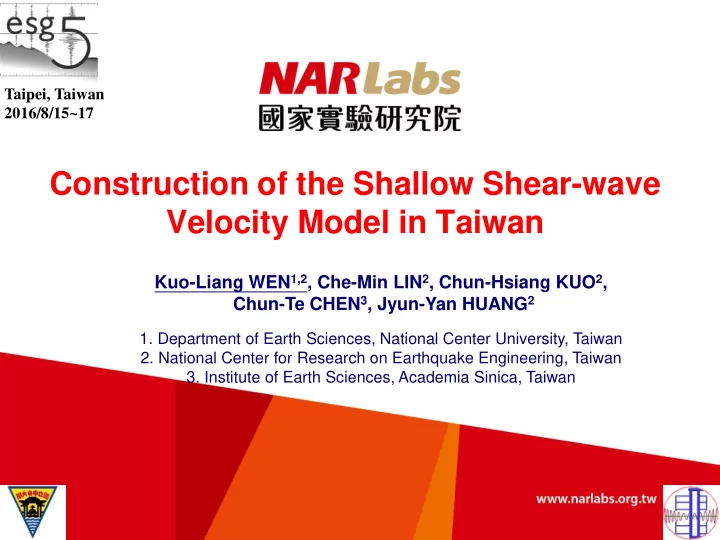

Taipei, Taiwan 2016/8/15~17 Construction of the Shallow Shear-wave Velocity Model in Taiwan Kuo-Liang WEN 1,2 , Che-Min LIN 2 , Chun-Hsiang KUO 2 , Chun-Te CHEN 3 , Jyun-Yan HUANG 2 1. Department of Earth Sciences, National Center University, Taiwan 2. National Center for Research on Earthquake Engineering, Taiwan 3. Institute of Earth Sciences, Academia Sinica, Taiwan
Introduction High Seismicity in Taiwan Strong site characteristics of the thick and soft Quaternary sediments Taipei Basin, Ilan Plain, Western Coastal Plain, Pingtung Plain (Fisher et al., 2002) 2
1986/11/15 V Hualien Eq. M L =6.8 IV IV III II
3F 台北縣中和市員山路之華陽市場,原為三層多柱少牆鋼筋混凝土的市場建築 物,由於 2 、 3 層改為住家後砌築了許多磚造外牆與隔間牆,使得建築物成為 上剛下軟的結構,加上過大的超載,在耐震上十分不利。在此次地震襲擊下, 幾乎大部份一、二樓的支柱折斷,造成 12 人死亡,數十人受傷的慘劇。
14F 台北市復興南路一段某大廈,一樓剪力牆腳及牆邊構材部份被壓碎,鋼 筋暴露且扭曲變形,牆面呈斜向之剪力龜裂,一、二樓間之混凝土樓板 破裂並下陷。
Depth contour to the basement top from deep drilling. (Central Geol. Surv.) 6
Introduction The resolutions of shallow part (within a depth of 1 or 2 km) of existing 3D tomography velocity models are insufficient A integrated and detail shallow velocity model of Taiwan is essential for ground motion prediction and simulation in the future Additional shallow model (Chen et al., 2016) (Lin, 2009) 7
Near-surface Data of Engineering Geological Database for TSMIP (EGDT) 8
Near-surface Data of Engineering Geological Database for TSMIP (EGDT) 447 stations (Kuo et al., 2012) 9
Receiver Function Analysis of TSMIP Stations RF was applied on the high-frequency acceleration seismograms recorded by TSMIP stations to estimate the Vs profiles TAP010 (Lin et al., 2014) 10
Receiver Function Analysis of TSMIP Stations (Lin et al., 2014)
Receiver Function Analysis of TSMIP Stations Taipei Basin Ilan Plain Top of Tertiary Basement Bottom of Sungshan Formation Top of Tertiary Basement (Lin, 2003) (Lin et al., 2014) Kaohsiung & Pingtung Area RF is sensitive to a boundary with high velocity contrast RF analysis has been applied at almost 400 TSMIP stations Providing a rough and preliminary model for further Vs > 0.5 Vs > 1.0 km/sec km/sec studies (Lin et al., 2016)
Microtremor Array 0 1 2 3 0 0.5 1 1.5 2 2.5 3 3.5 4 13
Microtremor Array Compared with EGDT and deep borehole data (Kuo et al., 2016)
Microtremor Array Compared with seismic structural maps (Lin et al., 2009) 15
Microtremor Array About 150 microtremor array measurements have been conducted in Taiwan Arrays with different layouts can provide velocity information of diverse depths or resolutions ESG5 poster: P102B (Chen et al.) 16
Modeling of Microtremor H/V Spectral Ratio (HVSR) A dense microtremor single-station survey of more than 4000 sites has been conducted to evaluate the detail site response all over Taiwan using the HVSR analysis The measurement intervals are mostly 2 km, and 1 km for some metropolitan regions. (Huang, 2009) 17
Modeling of Microtremor H/V Spectral Ratio (HVSR) Theoretical SH-wave transfer function of Haskell matrix (Haskell, 1960) shear-wave velocity model inverted by RF agree with the observed microtremor H/V spectral ratios at TSMIP stations The theoretical SH-wave transfer function can be used to model the microtremor H/V spectral ratios to estimate the S-wave velocity profiles for all sites (Lin et al., 2014) 18
Modeling of Microtremor H/V Spectral Ratio (HVSR) GA-Haskell method based on the combination of the Haskell matrix and Genetic Aalgorithm (GA) models the microtremor HVSR to estimate the V s velocity profile The fitness function of GA-Haskell is defined by linear correlation coefficient and dominant frequency. x x y y i i F F r 1 i SH HV r f 0 . 8 1 0 . 2 2 2 2 0 . 3 F x x y y HV i i i i 19
Modeling of Microtremor H/V Spectral Ratio (HVSR) Taipei Basin Sungshan Formation & HVSR dominant frequencies (Lin et al., 2014) 20
Modeling of Microtremor H/V Spectral Ratio (HVSR) Ilan Plain Western Plain Alluvium – Pleistocene boundary Soft soil – Alluvium boundary Engineering bedrock (Vs =600 m/sc) ESG5 poster: P102B Pleistocene – Miocene (Chen et al.) basement boundary ESG5 poster: P112B (Lin et al.) 21
Z 1.0 for GMPE EGDT 1000 RF H/V Array LK16_TW 100 Z1.0 [m] 10 1 100 1000 Vs30 [m/s] 22
Summary Near- EGDT, other downhole and surface geology data Surface Receiver Function Microtremor Array HVSR Modeling • 800 TSMIP stations • About 150 sites • More than 4000 sites Refer to geology, seismic and other geophysical surveys A detail and integrated shallow shear-wave velocity model for Taiwan ~2km 3D Tomography Models
Taipei, Taiwan 2016/8/15~17 Thank you for your attention! 24
Recommend
More recommend